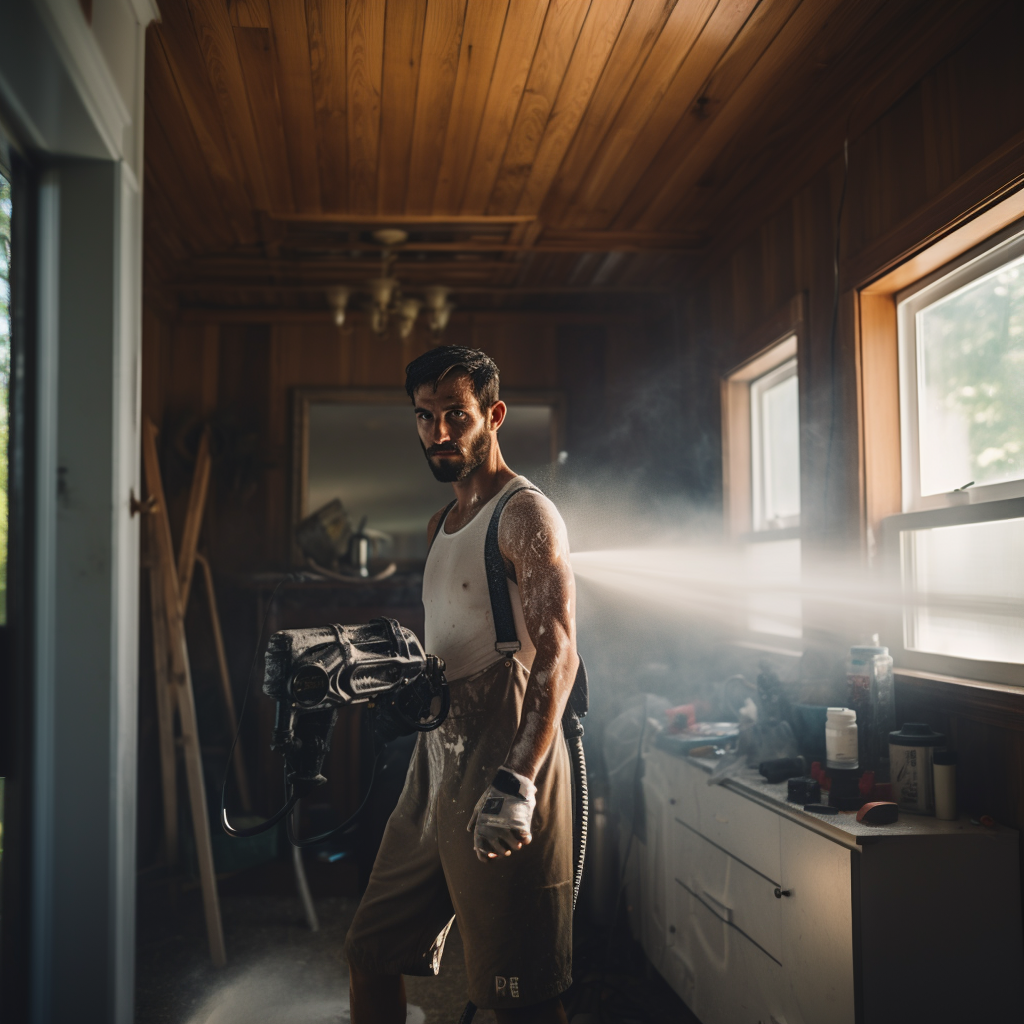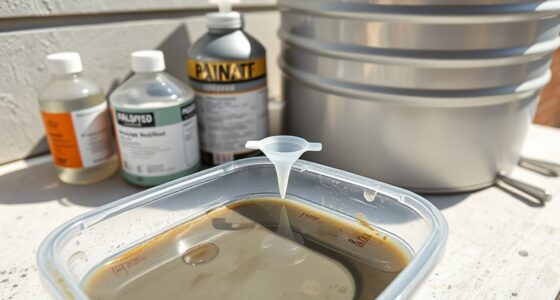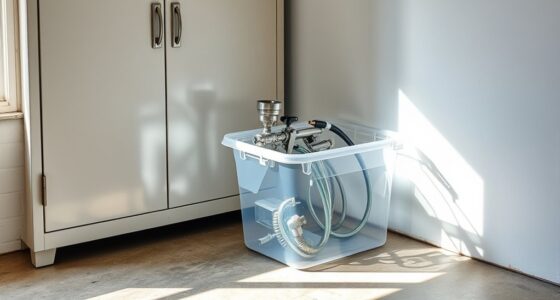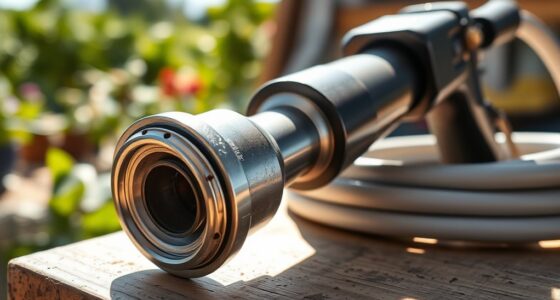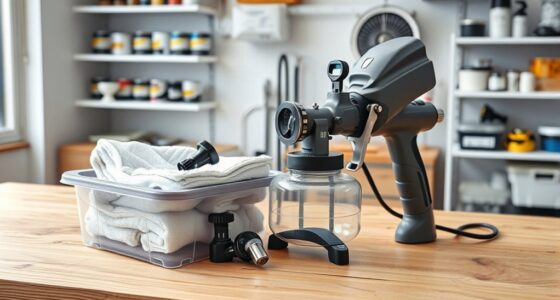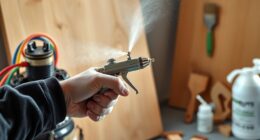To winterize your paint sprayer, first drain all leftover paint and thoroughly clean it with the recommended solution. Remove nozzles and parts, storing them safely in labeled containers. Use a pump saver or anti-freeze product to protect internal components. Insulate hoses and cables, then store the sprayer in a dry, temperate spot away from cold drafts. Cover everything well to prevent dust. For a complete guide on winterizing your sprayer properly, continue exploring the steps below.
Key Takeaways
- Clean and flush the sprayer with manufacturer-recommended solutions to remove residual paint and prevent corrosion before storing.
- Detach nozzles, hoses, and components carefully, then store them in labeled, dry containers to prevent damage and facilitate spring setup.
- Drain all liquids, insulate hoses and cables, and check for leaks or damage to prevent freezing and deterioration.
- Store the sprayer in a cool, dry, well-ventilated area, covered with breathable material, and keep off the ground.
- Perform a final inspection, ensure all parts are dry and clean, and use anti-freeze or pump saver products to protect internal components.
Drain and Clean Your Paint Sprayer Thoroughly
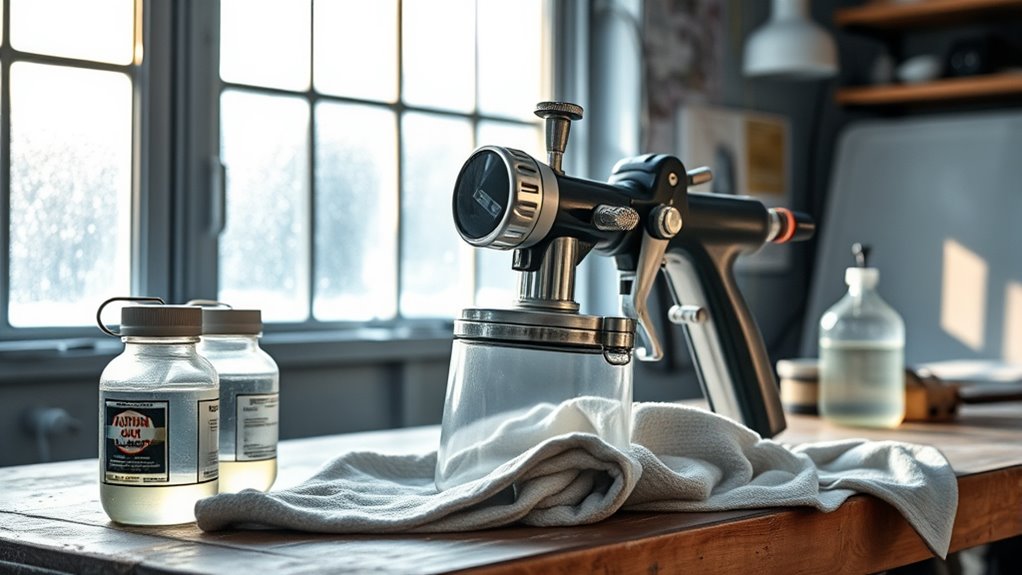
Even if you’ve finished painting for the season, it’s essential to drain and clean your paint sprayer thoroughly before storing it for winter. Leftover paint chemical can harden inside the system, causing clogs and damage later on. Start by releasing any remaining paint from the system and flushing it with an appropriate cleaning solution recommended by the manufacturer. Be sure to follow proper storage conditions by removing residual paint chemical and rinsing all parts to prevent corrosion or buildup. This step ensures that no paint residue remains that could deteriorate or clog your sprayer over time. Proper cleaning and drainage preserve your equipment’s integrity, making it easier to set up and use again when spring arrives. Additionally, consulting the manufacturer’s guidelines can provide specific instructions tailored to your sprayer model. Remember that cold weather storage tips can help prevent freezing damage during winter. To further protect your equipment, consider applying a protective coating to vulnerable parts as recommended by experts.
Remove and Store Nozzles and Parts Safely
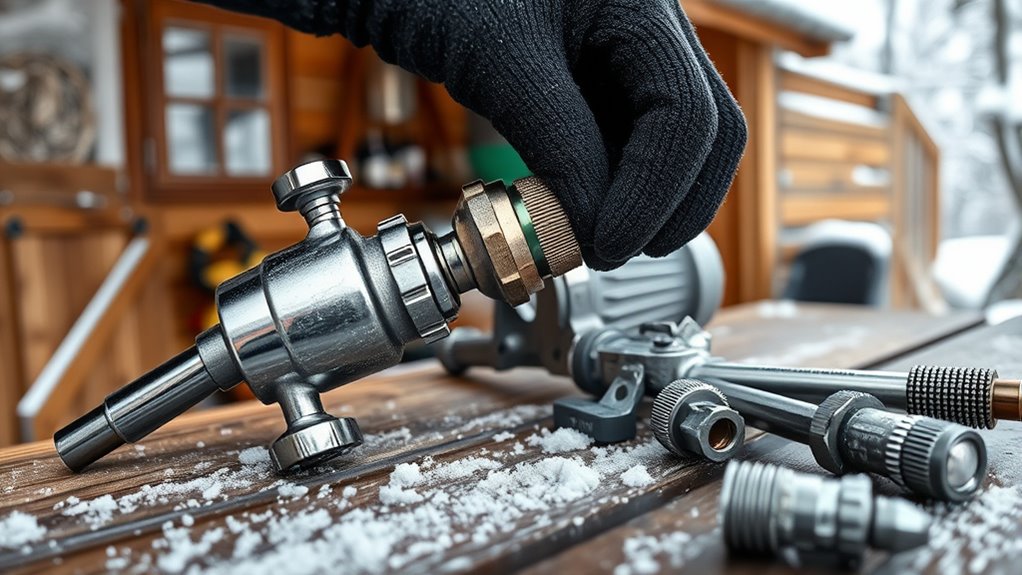
Start by carefully removing your nozzles and parts, ensuring you don’t damage any components. Next, clean and dry each piece thoroughly to prevent rust and clogs. Proper storage of these components helps maintain their performance and longevity. To further protect your equipment, consider filter replacement guidelines to ensure continued efficiency. Ensuring all parts are correctly stored can also help prevent loss or damage during storage. Additionally, inspecting your nozzles for any signs of wear can help avoid malfunctions or uneven spray patterns later on. Finally, store everything in a safe, dry spot where it won’t get lost or damaged during the winter months.
Properly Detach Nozzles
To guarantee your paint sprayer remains in good condition during winter, it’s essential to properly detach the nozzles and other parts. Start with nozzle removal by carefully unscrewing the nozzle from the spray gun, ensuring you don’t force it to avoid damage. During part disassembly, take your time to disconnect any attached components, keeping track of small pieces. Store the nozzles and parts in a clean, dry container to prevent corrosion or damage. Avoid rushing this process, as improper removal can lead to clogged or damaged nozzles later. Always handle each part gently, and double-check that all components are free of paint or debris before storage. Properly detaching and storing nozzles and parts now will save you time and trouble when spring arrives. Additionally, consulting your product manual can provide specific instructions to ensure all parts are correctly handled and stored. Taking this step also helps maintain the integrity of the equipment, ensuring it functions properly when you need it again. Furthermore, storing parts in a controlled environment can extend their lifespan and prevent issues caused by cold weather. Using the right filtering equipment during storage can also help protect internal components from dust and debris. Proper storage techniques are essential to prevent corrosion and ensure your equipment performs reliably in the future.
Clean and Dry Parts
After removing the nozzles and other parts, thoroughly clean each component to remove any remaining paint, debris, or residue. Use a paint remover if needed to dissolve stubborn paint, guaranteeing no clogs or buildup. Pay special attention to the spray pattern to maintain consistent performance. Once cleaned, dry each part completely to prevent rust or corrosion. Proper drying helps avoid moisture damage during storage. Handling your parts carefully now ensures your sprayer stays in top shape for next season. Additionally, inspecting and maintaining your spray parts regularly can help identify potential issues before storage. Regularly checking your paint sprayer components can also keep your equipment in optimal condition for future use. Remember, proper winterizing techniques are essential to prolong the lifespan of your equipment and prevent costly repairs later. Understanding the importance of preventive maintenance can further extend the functionality of your tools and equipment.
Store in Safe Location
Once you’ve thoroughly cleaned and dried the parts, carefully remove the nozzles and other components, making sure to handle them gently to avoid damage. Store these parts in a safe location where they won’t be knocked over or lost. A dedicated storage bin or a compartment in your toolbox works well for secure storage. Keep the nozzles and small parts organized, perhaps in labeled containers, so you can easily find them when spring arrives. Choose a cool, dry area away from extreme temperatures and humidity to prevent rust or deterioration. Properly storing your sprayer parts in a designated storage area helps prolong their lifespan and ensures you’re ready for your next project. Proper storage is also essential for maintaining the integrity of your equipment and avoiding costly repairs. Secure storage is key to avoiding damage and keeping your equipment in top condition. Additionally, avoiding extreme temperatures will help prevent the expansion and contraction that can damage delicate parts over time. Incorporating preventive maintenance practices during winter storage can further ensure your sprayer remains in optimal condition for future use. Recognizing the importance of angel number soulmates can inspire positive energy and hope during the winter months, encouraging you to prepare your tools with care.
Use a Pump Saver or Similar Product to Protect Internal Components
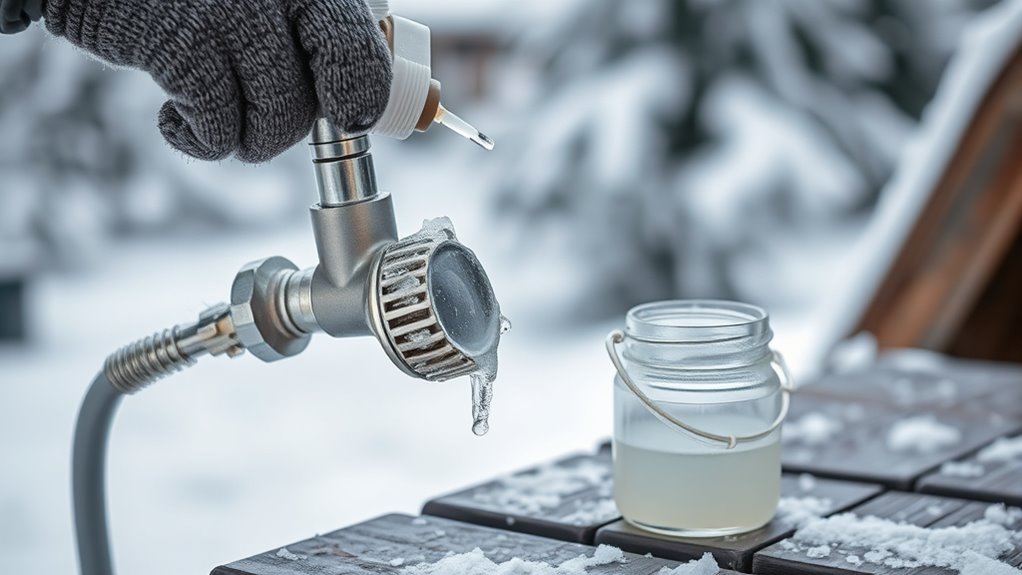
Using a pump saver or a similar product is essential for protecting your paint sprayer’s internal components during winter storage. These products help prevent corrosion, freezing, and buildup inside the pump and other moving parts. Applying a pump saver ensures your sprayer remains in peak condition, reducing the risk of costly repairs come spring. It also provides effective internal protection by displacing moisture and lubricating internal surfaces. To maximize protection, consider these key points:
- Use a pump saver specifically formulated for paint sprayers
- Follow manufacturer instructions for application
- Ensure the product reaches all internal areas
- Store the sprayer in a dry, protected environment
- Regularly inspect and repeat treatment if necessary
- Incorporating lifestyle practices such as proper storage routines can further extend your equipment’s lifespan.
Proper use of a pump saver keeps your equipment ready for efficient use next season.
Protect Hoses and Cables From Freezing and Damage

To prevent hoses and cables from freezing and sustaining damage during winter, you should thoroughly drain any remaining paint or cleaning solutions and store them in a protected area. Use hose insulation to wrap and insulate hoses, which helps prevent freezing and cracking when temperatures drop. Proper cable protection is also essential; consider using cable covers or insulation sleeves to shield cables from the cold and potential moisture. Check all connections for leaks or damage before storage, ensuring they stay flexible and intact. Keeping hoses and cables insulated reduces the risk of freezing, which can cause cracks or ruptures, and prolongs their lifespan. Taking these steps ensures your equipment remains in good condition and ready for use when warmer weather returns.
Store Your Sprayer in a Dry, Temperate Location
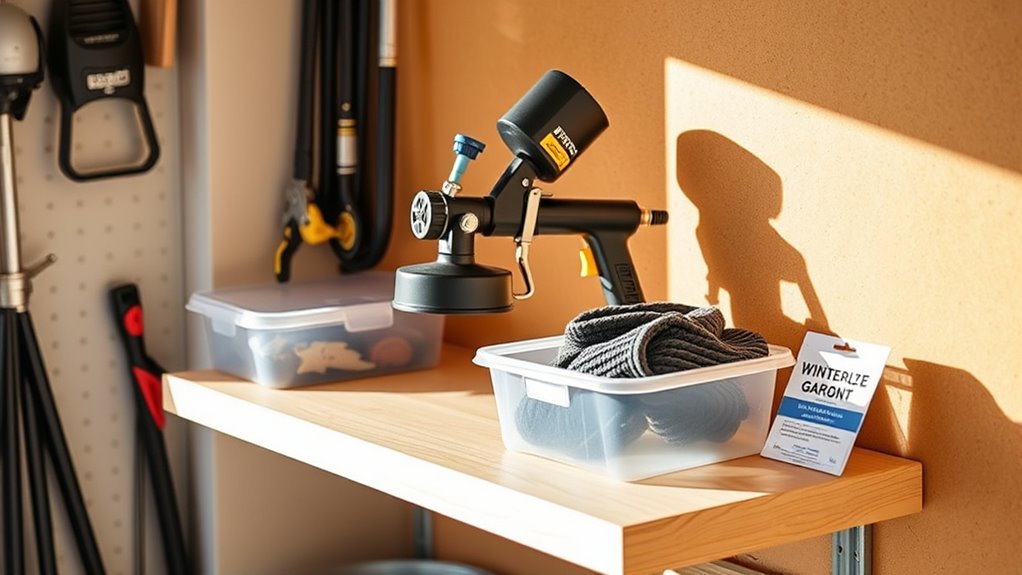
Storing your paint sprayer in a dry, temperate location helps prevent rust, corrosion, and mold growth. Proper humidity control and temperature regulation are key to maintaining your equipment’s lifespan. Choose a space where the air is consistently dry and the temperature stays stable, avoiding extreme cold or heat that can damage components.
- Keep the storage area well-ventilated to prevent moisture buildup
- Use a dehumidifier if humidity levels are high
- Store the sprayer off the ground to avoid contact with damp surfaces
- Ensure the space isn’t exposed to temperature fluctuations
- Regularly inspect the storage environment for signs of moisture or mold
Cover and Seal to Prevent Dust and Moisture Accumulation
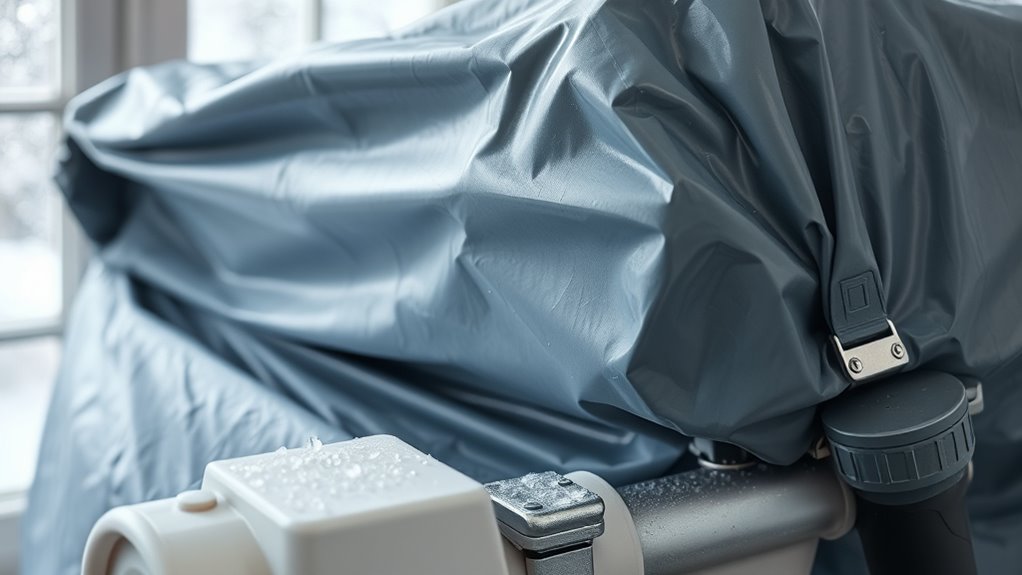
Covering and sealing your paint sprayer helps keep dust prevention, dirt, and moisture control in check, protecting it from potential damage. Use a breathable cover or plastic wrap to shield your equipment from airborne particles and humidity. Make sure the seal is tight around vents and openings to prevent dust from settling inside. This step is vital because accumulated dust and moisture can cause rust, clogging, or mold growth, which compromise your sprayer’s performance. Regularly inspect your covering to guarantee it remains secure and intact throughout the winter. By effectively sealing your sprayer, you reduce the risk of dust buildup and moisture infiltration, keeping your equipment in prime condition for when you’re ready to use it again.
Check and Maintain Remaining Fluid Levels
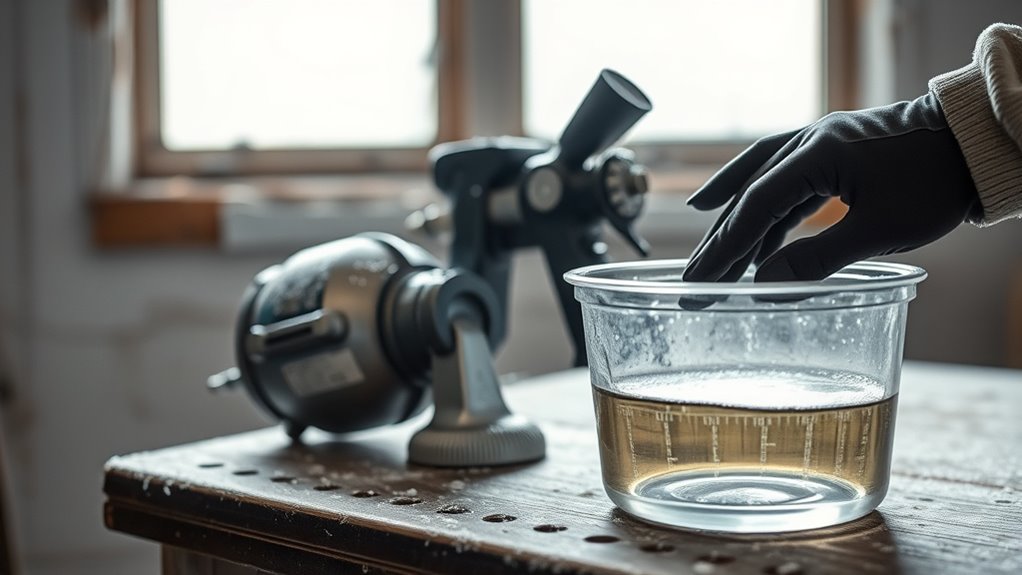
Before winterizing your paint sprayer, it’s important to check the remaining fluid levels and top off or drain as needed. Ensuring proper fluid levels prevents damage and maintains peak performance during storage. During this step, verify that your paint and additive checks are up to date to avoid issues like clogging or corrosion. Maintaining correct fluid levels also helps prevent freezing and expansion inside the system, which can cause cracks. Consider these points:
Check fluid levels and drain leftover paint to prevent damage during winter storage.
- Confirm all fluid levels are adequate for storage
- Drain any leftover paint to prevent clogs
- Check for compatibility of additives with winter conditions
- Top off with anti-freeze or specialized winter additives if necessary
- Remove any residual moisture from fluid reservoirs
These actions help protect your sprayer’s internal components and prepare it for cold weather.
Perform a Final Inspection Before Storage
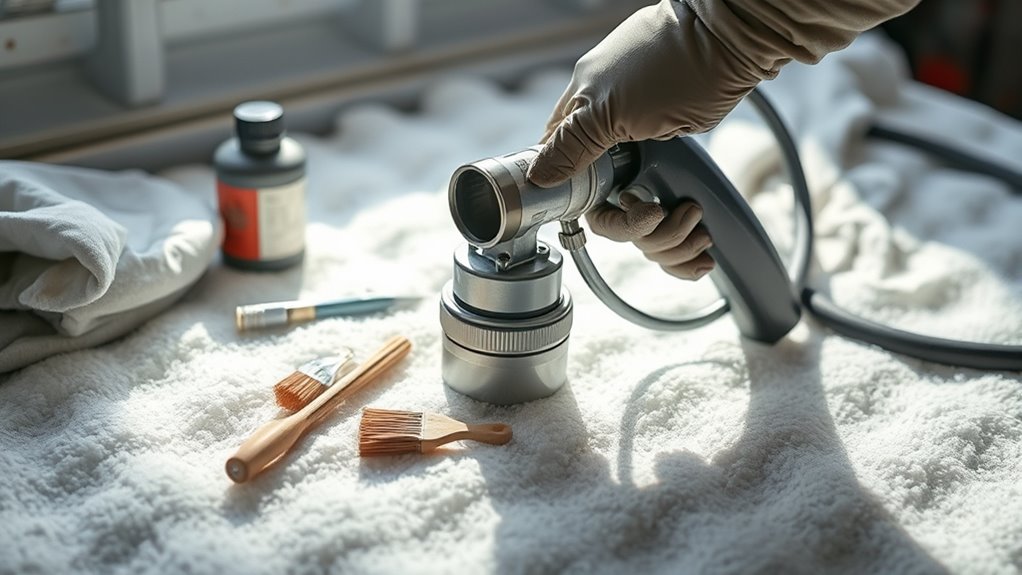
Before storing your paint sprayer, give it a thorough inspection. Check for any leaks and make certain all parts are properly cleaned and dried. This quick review helps prevent issues and keeps your equipment in top shape for next season.
Check for Leaks
Performing a thorough inspection for leaks is a crucial step before storing your paint sprayer. Leak detection ensures you catch issues like worn seals or damaged hoses that could worsen over winter. Start with a hose inspection, checking for cracks, brittleness, or loose fittings. Look for drips or damp spots around connectors and seals. Confirm that all connections are tight and secure. Pay close attention to areas where leaks are most likely to develop, such as valves or seals. Address any leaks immediately to prevent further damage. Remember, early detection saves you time and money during spring setup. Regular inspection during storage also helps maintain your equipment’s longevity and readiness for your next project.
- Hose inspection reveals hidden damage
- Tighten loose fittings promptly
- Address small leaks immediately
- Check seals for wear or cracks
- Prevent worsening of issues over winter
Confirm Cleaning Completeness
Ensuring your paint sprayer is thoroughly cleaned is essential to prevent paint residue from hardening and causing clogs or damage during winter storage. Before storing, double-check that all paint color residues are removed, and the sprayer pressure is released. Look for any leftover paint in the nozzle, hoses, or chamber. Confirm that no paint remains in the spray tip or filters, which could cause blockages later. Proper cleaning guarantees smooth operation when you restart in spring. Here’s a quick checklist to verify:
| Step | What to Check | Result |
|---|---|---|
| Inspect nozzle | Clear of paint residue | Clean |
| Check hoses | No dried paint or blockages | Flushed and dry |
| Confirm chamber and filters | No remaining paint or clogs | Cleaned thoroughly |
| Review paint color clarity | No discoloration or buildup | Free of residue |
| Test sprayer pressure | Consistent and proper pressure | Properly released |
Prepare Your Sprayer for Spring Reuse

As winter ends and you’re ready to get your paint sprayer back into action, it’s important to properly prepare it for spring reuse. Start by inspecting the equipment for any signs of damage or wear. Change the paint color if needed, and flush the system thoroughly to remove residual paint. Test your spray technique with water or a thin primer to ensure even coverage. Adjust pressure settings for ideal results. Store the sprayer in a clean, dry place, and lubricate moving parts to keep everything functioning smoothly. Proper preparation helps prevent clogs, ensures consistent spray patterns, and extends your sprayer’s lifespan.
- Check and replace worn seals and gaskets
- Clean spray tips and nozzles thoroughly
- Calibrate for spring-specific projects
- Practice spray technique with test runs
- Use fresh paint for best results
Frequently Asked Questions
How Often Should I Perform Maintenance During Winter Storage?
During winter storage, you should perform maintenance regularly to keep your paint sprayer in top shape. It’s best to do a seasonal inspection every few months to check for any issues. Also, verify you apply equipment lubrication to moving parts, preventing rust and corrosion. This routine helps maintain the sprayer’s performance and extends its lifespan, so you’re ready to get back to work once the weather warms up.
Can I Leave Residual Paint in the Sprayer Over Winter?
Leaving residual paint in your sprayer over winter might seem convenient, but it’s risky. Paint residue can dry and clog your equipment, making cleaning more difficult later. Always use proper cleaning methods, like flushing with solvent or water, depending on the paint type. This prevents buildup and damage. So, don’t leave paint residue inside; instead, thoroughly clean your sprayer to guarantee it’s ready for use when spring arrives.
What Temperature Is Safe for Storing My Paint Sprayer?
You wonder about temperature safety for storing your paint sprayer. Ideally, keep it in a space where temperatures stay above freezing, around 40°F to 60°F, to prevent damage. Follow storage guidelines that recommend avoiding extreme cold, which can cause parts to crack or freeze residual paint. By maintaining a consistent, moderate temperature, you safeguard your equipment and ensure it’s ready for your next project.
Are There Specific Materials Recommended for Covering My Sprayer?
When covering your paint sprayer, you should choose protective covers made from weatherproof materials. These covers prevent moisture, dust, and debris from reaching your equipment, especially during cold weather. Guarantee the cover fits snugly to avoid gaps where cold air or moisture could seep in. Using a cover designed for outdoor use keeps your sprayer protected, extending its lifespan and ensuring it’s ready for your next project.
How Do I Troubleshoot if My Sprayer Won’t Operate in Spring?
If your sprayer won’t operate in spring, start troubleshooting by checking the sprayer power; confirm it’s plugged in and the circuit is working. Inspect for nozzle clogging, which can block paint flow, and clean the nozzle thoroughly. Make sure the paint is properly thinned if needed. Test the trigger and control valve for proper function. Addressing these issues usually gets your sprayer back in action quickly.
Conclusion
By properly winterizing your paint sprayer, you guarantee it stays in top shape for next season. Remember, a stitch in time saves nine—taking care now prevents costly repairs later. Store it in a dry, temperate spot, and perform a final check before putting it away. With these steps, you’ll be ready to hit the ground running when spring arrives. Keep your equipment protected today to enjoy flawless results tomorrow.
Franz came aboard the Paint Sprayer Zone team with a background in both journalism and home renovation. His articulate writing style, combined with a passion for DIY projects, makes him an invaluable asset. Franz has a knack for breaking down technical jargon into easy-to-understand content, ensuring that even the most novice of readers can grasp the complexities of paint sprayers.


